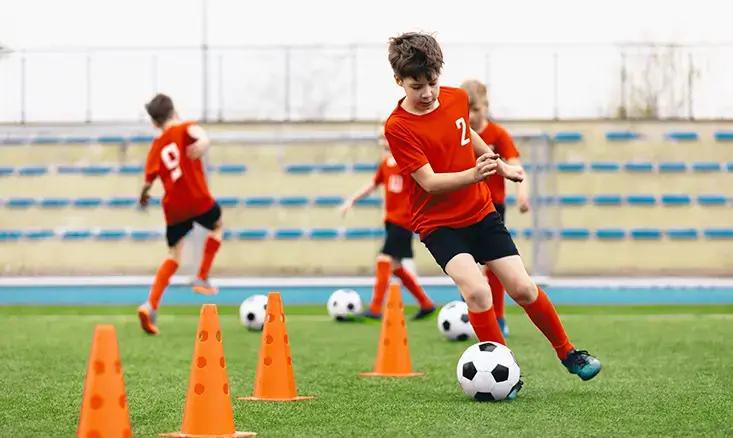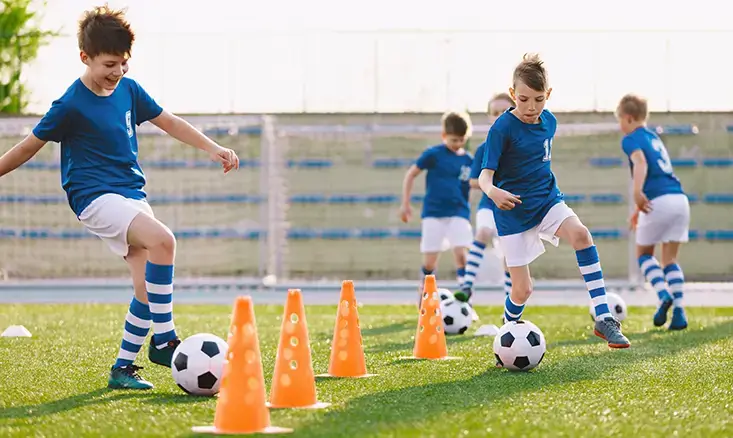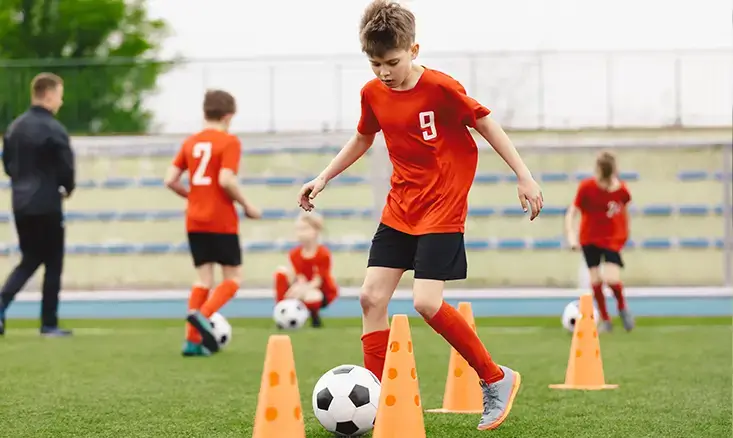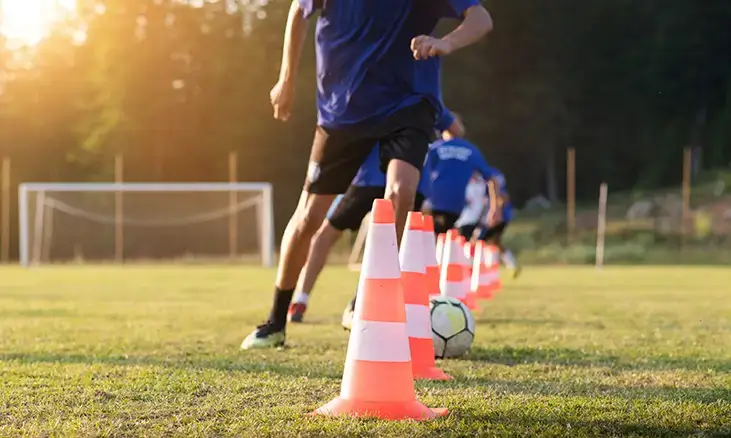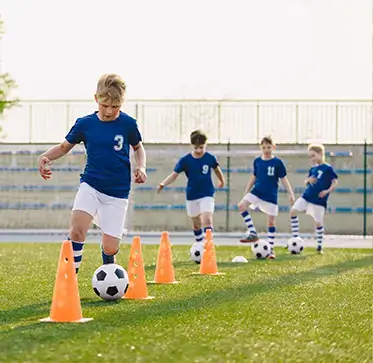Footwork is an important soccer skill for both beginners and advanced players. Developing good footwork from a young age helps players improve their ball control, agility, and overall performance on the field. This article provides a comprehensive guide to soccer footwork drills, including drills for beginners and advanced players.
When starting with soccer footwork drills, focusing on the basics is essential. These foundational drills are perfect for beginners, providing a solid grounding in ball control and movement.
Toe touches are an essential soccer footwork drill that improves balance and coordination. This drill is perfect for beginners because it can be done without much space and doesn’t require advanced skills. Simply touch the ball with your toes, alternating feet, while keeping the ball stationary. This drill can also serve as a warm-up exercise. Over time, increase the speed of the touches to challenge yourself and improve your foot speed.
Sole rolls teach players how to move the ball laterally using the underside of their feet. This basic dribbling move helps players navigate around defenders and avoid tackles. Set two cones 10-15 yards apart, roll the ball forward with the sole of your foot, and step with the opposite leg. Repeat this in a “1-2” rhythm while keeping the ball close to your body. As you become more comfortable, try to perform the drill with your eyes up, focusing on your surroundings rather than the ball.
As players progress, intermediate soccer footwork drills help refine their skills and prepare them for more competitive play. These drills are equally suitable for 6-year-olds and 11-year-olds, providing a base for advanced techniques.
The inside-outside cone drill is perfect for enhancing ball control and dribbling skills. Set up six cones in a vertical line, and move the ball in a zigzag pattern using the inside and outside of your feet. This drill helps players get comfortable with changing directions quickly. To increase difficulty, reduce the space between the cones and focus on quick, precise touches. This drill is excellent for improving agility and quick thinking under pressure.
This drill integrates inside foot touches with sole rolls, helping players get comfortable with ball movement. Set up two cones 10-15 yards apart, and touch the ball with the inside of your right foot, then the inside of your left foot, followed by a sole roll. This sequence improves dribbling skills and ball control. As you advance, try to increase your speed and minimize the time the ball is not in contact with your feet.
This advanced drill uses both feet interchangeably, improving control. Set up six cones in a vertical line. Use the inside and outside of your feet to move the ball around the cones. This drill is excellent for more experienced players who want to refine their footwork skills. Focus on maintaining a low center of gravity and quick, sharp movements to enhance your ability to navigate through tight spaces on the field.
Alternating kick-arounds train timing, touch, balance, and foot-eye coordination. Stand over the ball, roll it from one foot to the other, and circle your foot around the ball before trapping it. Gradually increase your speed as you get more comfortable with the drill. This drill is particularly effective for developing the ability to maintain control of the ball under pressure from defenders.
Focusing on specific skills is crucial for comprehensive soccer training. These drills target particular abilities to enhance overall performance.
Creating real game scenarios in practice helps players apply their skills under match conditions. These drills are designed to mimic the pressures and challenges of actual games.
Practicing one-on-one play simulates match pressure and develops defensive and offensive skills. Set up two cones 10 yards apart. One player starts with the ball and tries to get past the other player. This drill helps players practice real-game scenarios and improve their footwork under pressure. To add variety, incorporate different levels of physicality and strategic approaches, such as emphasizing defensive positioning or attacking creativity.
A scrimmage is a full-game simulation that allows players to practice all their skills in a real-game setting. Set up a full soccer field with two goals. Players follow regular game rules, with coaches providing guidance and feedback. Scrimmages help identify areas for improvement and prepare players for actual matches. Encourage players to apply the skills learned in drills during the scrimmage and focus on teamwork, communication, and strategic play.
Heading is an important soccer skill, requiring precision and control. These drills help players improve their heading abilities for both offensive and defensive situations.
Practicing headers involves using the head to direct the ball. Stand in front of a partner, who tosses the ball lightly. Use your head to hit the ball. This drill helps improve accuracy and control with headers. Focus on using the forehead to strike the ball and keeping your eyes open to maintain control and direction.
This drill focuses on both offensive and defensive headers. Set up as in the previous drill, but vary the type of header based on instructions. Practice directing the ball downward for offensive headers and upward for defensive headers. This drill enhances players’ ability to use their heads effectively in different game situations. Incorporate movement and positional awareness to simulate real-game scenarios and improve heading under pressure.
By following these tips and consistently practicing the outlined drills, you can develop the skills needed to excel in soccer. Keep challenging yourself, stay dedicated, and enjoy the journey of becoming a better soccer player.
Consistent practice of these soccer footwork drills will significantly improve a player’s skills and performance on the field. Whether you are a beginner, a young soccer player, or an advanced player, incorporating these drills into your training routine will help you develop better ball control, agility, and foot speed. Remember, the key to success in soccer is practice and dedication. By focusing on these drills and regularly challenging yourself, you will see substantial improvement in your footwork and overall game performance.
Mastering footwork in soccer requires consistent practice of drills like toe touches, sole rolls, and the inside-outside cone drill, focusing on agility, ball control, and quick direction changes.
Fast footwork in soccer refers to the ability to move one’s feet quickly to maintain control over the ball, evade defenders, and navigate the field efficiently, often practiced through rapid succession drills like toe touches.
Pivot footwork involves rotating the body around a single foot to change direction quickly while maintaining balance and control, useful in evading opponents and shifting play direction.
Defensive footwork in soccer focuses on positioning and movement to effectively block opponents, intercept passes, and clear the ball from dangerous areas, requiring drills that emphasize agility and quick responses.
Footwork in soccer primarily engages the lower body muscles, including the quadriceps, hamstrings, calves, and glutes, along with core muscles for stability and balance during movements.
